电子商务英文版最新课件ec13_ppt_ch10_accessible
合集下载
电子商务英文版最新课件ec13_ppt_ch06_accessible

• Online research influenced over $1.3 trillion of retail purchases in 2016
• Online traffic also influenced by offline brands and shopping
• E-commerce and traditional commerce are coupled: Part of a continuum of consuming behavior
• About 9% of Internet users don’t shop online – Trust factor – Hassle factors (shipping costs, returns, etc.)
Trust, Utility, and Opportunism in Online Markets
Consumers Online: The Internet Audience and Consumer Behavior (1 of 3)
• Over 75% (92 million) of U.S. households had broadband Internet access in 2016
• Two most important factors shaping decision to purchase online: – Utility: ▪ Better prices, convenience, speed – Trust: ▪ Perception of credibility, ease of use, perceived risk ▪ Sellers develop trust by building strong reputations for honesty, fairness, delivery
• Online traffic also influenced by offline brands and shopping
• E-commerce and traditional commerce are coupled: Part of a continuum of consuming behavior
• About 9% of Internet users don’t shop online – Trust factor – Hassle factors (shipping costs, returns, etc.)
Trust, Utility, and Opportunism in Online Markets
Consumers Online: The Internet Audience and Consumer Behavior (1 of 3)
• Over 75% (92 million) of U.S. households had broadband Internet access in 2016
• Two most important factors shaping decision to purchase online: – Utility: ▪ Better prices, convenience, speed – Trust: ▪ Perception of credibility, ease of use, perceived risk ▪ Sellers develop trust by building strong reputations for honesty, fairness, delivery
电子商务讲解课件(英文)Lecture

Customer service
Effective channels for customers to get help and resolve issues.
03
E-commerce Businesses
Marketplace
Marketplace Amazon Alibaba eBay
A platform that brings together buyers and sellers to facilitate transactions.
A crowdfunding platform that allows individuals or groups to raise funds for personal causes or charitable
projects.
Airbnb
A peer to peer e-commerce platform that allows
01
02
03
起始阶段
20世纪90年代初,电子商 务出现,以静态网页展示 产品信息。
发展阶段
20世纪90年代末至21世 纪初,电子商务平台兴起 ,在线购物逐渐普及。
成熟阶段
21世纪中期至今,移动支 付、社交电商、跨境电商 等多元化模式涌现。
Types of E-commerce
01
02
03
04
B2B (Business-to-Business) :企业与企业之间的电子商务
Bitcoin, Ethereum, etc., used for secure, decentralized transactions.
Delivery and Logistics
In-store pickup
Effective channels for customers to get help and resolve issues.
03
E-commerce Businesses
Marketplace
Marketplace Amazon Alibaba eBay
A platform that brings together buyers and sellers to facilitate transactions.
A crowdfunding platform that allows individuals or groups to raise funds for personal causes or charitable
projects.
Airbnb
A peer to peer e-commerce platform that allows
01
02
03
起始阶段
20世纪90年代初,电子商 务出现,以静态网页展示 产品信息。
发展阶段
20世纪90年代末至21世 纪初,电子商务平台兴起 ,在线购物逐渐普及。
成熟阶段
21世纪中期至今,移动支 付、社交电商、跨境电商 等多元化模式涌现。
Types of E-commerce
01
02
03
04
B2B (Business-to-Business) :企业与企业之间的电子商务
Bitcoin, Ethereum, etc., used for secure, decentralized transactions.
Delivery and Logistics
In-store pickup
电子商务课件unit1(2024)

27
电子商务物流模式与选择
1 2
电子商务物流模式
自营物流、第三方物流、第四方物流等。
电子商务物流模式的选择
根据企业规模、业务需求、成本预算等因素综合 考虑,选择最适合的物流模式。
3
电子商务物流模式的发展趋势
向智能化、绿色化、全球化方向发展。
2024/1/28
28
供应链管理与优化
要点一
供应链管理的定义
7
电子商务的分类与应用领域
要点一
B2B(Business-to-Business)
企业与企业之间的电子商务模式,如供应链管理和采购平 台等。
要点二
B2C(Business-to-Consumer )
企业与消费者之间的电子商务模式,如网上零售和在线购 物等。
2024/1/28
8
电子商务的分类与应用领域
16
03
电子商务模式与案例分析
2024/1/28
17
B2B电子商务模式
定义
B2B(Business-to-Business) 电子商务模式是指企业与企业之 间通过互联网进行交易活动的商
业模式。
特点
交易双方均为企业或商家,交易 规模大,交易过程复杂。
案例分析
阿里巴巴是B2B电子商务模式的 典型代表,通过搭建一个线上的 交易平台,帮助全球的中小企业 寻找合适的买家和卖家,实现跨
电子支付的意义
电子支付提高了支付的效率和便捷性,降低了交易成本,促进了 电子商务的发展。
23
电子支付工具与方式
信用卡支付
通过信用卡进行在线支付,包 括输入卡号、有效期、CVV码
等信息完成支付。
2024/1/28
第三方支付
电子商务物流模式与选择
1 2
电子商务物流模式
自营物流、第三方物流、第四方物流等。
电子商务物流模式的选择
根据企业规模、业务需求、成本预算等因素综合 考虑,选择最适合的物流模式。
3
电子商务物流模式的发展趋势
向智能化、绿色化、全球化方向发展。
2024/1/28
28
供应链管理与优化
要点一
供应链管理的定义
7
电子商务的分类与应用领域
要点一
B2B(Business-to-Business)
企业与企业之间的电子商务模式,如供应链管理和采购平 台等。
要点二
B2C(Business-to-Consumer )
企业与消费者之间的电子商务模式,如网上零售和在线购 物等。
2024/1/28
8
电子商务的分类与应用领域
16
03
电子商务模式与案例分析
2024/1/28
17
B2B电子商务模式
定义
B2B(Business-to-Business) 电子商务模式是指企业与企业之 间通过互联网进行交易活动的商
业模式。
特点
交易双方均为企业或商家,交易 规模大,交易过程复杂。
案例分析
阿里巴巴是B2B电子商务模式的 典型代表,通过搭建一个线上的 交易平台,帮助全球的中小企业 寻找合适的买家和卖家,实现跨
电子支付的意义
电子支付提高了支付的效率和便捷性,降低了交易成本,促进了 电子商务的发展。
23
电子支付工具与方式
信用卡支付
通过信用卡进行在线支付,包 括输入卡号、有效期、CVV码
等信息完成支付。
2024/1/28
第三方支付
电子商务英文版最新课件ec13_ppt_ch05_accessible

Table 5.3 Customer and Merchant Perspectives on the Different Dimensions of E-Commerce Security (1 of 2)
Dimension Integrity
Customer’s Perspective
Has information I transmitted or received been altered?
– E-signatures – Multi-factor authentication – Fingerprint identification
• Three key points of vulnerability in e-commerce environment: – Client – Server – Communications pipeline (Internet communications channels)
Figure 5.2 A Typical E-Commerce Transaction
• Low-cost web attack kits • Online credit card fraud • Underground economy marketplace
What Is Good E-Commerce Security?
• To achieve highest degree of security – New technologies – Organizational policies and procedures – Industry standards and government laws
Availability
Customer’s Perspective Can someone other than the intended recipient read my messages?
电子商务英文版最新课件ec13_ppt_ch04_accessible

tracking
Engage customers in conversations Execute a transaction
Accumulate customer information
On-site blog; user forums
Shopping cart/payment system
Customer database
Imagine Your E-Commerce Presence (1 of 3)
• What’s the idea? The vision includes: – Mission statement – Target audience – Intended market space – Strategic analysis – Marketing matrix – Development timeline – Preliminary budget
Business Objective SysБайду номын сангаасem Functionality
Display goods
Digital catalog
Provide product information
Product database
Personalize/customize Customer on-site
product
Figure 4.6(A) Logical Design for a Simple Website
Figure 4.6(B) Physical Design for a Simple Website
Product and inventory levels, supplier ID and contact, order quantity data by product
电子商务英文版最新课件ec13_ppt_ch01_accessible

Assessing E-Commerce (1 of 2)
• Stunning technological success • Early years a mixed business success
– Few early dot-coms have survived – Online sales growing rapidly • Many early visions not fulfilled – Price dispersion – Information asymmetry – New intermediaries
Uber: The New Face of E-Commerce?
• Class Discussion – Have you used Uber or any other on-demand service companies? – What is the appeal of these companies for users and providers? – Are there any negative consequences to the increased use of on-demand services like Uber and Airbnb?
Assessing E-Commerce (2 of 2)
• Other surprises – Fast-follower advantages – Start-up costs – Impact of mobile platform – Emergence of on-demand e-commerce
1.2 Define e-commerce, understand how e-commerce differs from ebusiness, identify the primary technological building blocks underlying ecommerce, and recognize major current themes in e-commerce.
电子商务英语PPT演示文稿

本演示文稿首先通过热身讨论引入电子商务英语的主题,探讨了电子商务公司提供的服务类型及其在电子商务中的角色。接着,介绍了电子商务的背景信息,强调物流过分析部分,深入探讨了电子商务时代物流面临的挑战,特别是在B2C和B2B领域。在B2C电子商务中,快速可靠的交付是赢得市场竞争优势的关键。而在B2B电子商务中,竞争焦点已从产品转向服务,实际上是供应链之间的竞争。此外,还指出了电子商务对物流服务的高要求,包括响应性和灵活性。响应性要求物流系统能够更好地满足客户的即时配送需求,而灵活性则是应对传统物流优化设施固定性的挑战。通过这些内容,本演示文稿全面介绍了电子商务英语的相关知识,帮助读者更好地理解和应对电子商务领域的实际问题和挑战。
电子商务英文版最新课件ec13_ppt_ch07_accessible
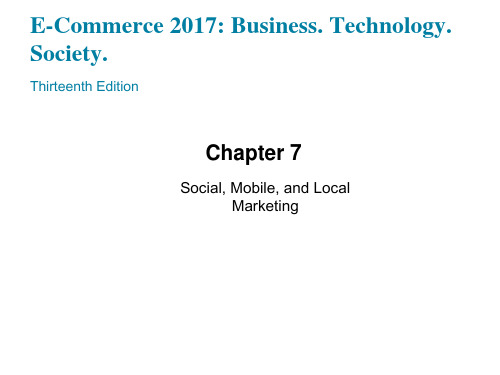
Introduction to Social, Mobile, and Local Marketing
• New marketing concepts – Conversations – Engagement
• Impact of smartphones and tablets • Social-mobile-local nexus
Social Marketing Players
• The most popular sites account for over 90% of all social network visits – Facebook, Google+, Twitter, LinkedIn, Pinterest, Instagram, Tumblr – Unique visitors vs. engagement ▪ Engagement measures the amount and intensity of user involvement ▪ Facebook dominates in both measures – Dark social – sharing outside of major social networks (e-mail, IM, texts, etc.)
Typical Twitter Marketing Campaign
• Follow others relevant to your content and conversation • Experiment with simple Promoted Tweets • For larger budgets, use Promoted Trends and TV ad
• Facebook analytics tools – Facebook Page Insights – Social media management systems (HootSuite) – Analytics providers (Google Analytics, Webtrends)
电子商务英文版最新ppt课件ec13 ch05 accessible

• Cybervandalism: – Disrupting, defacing, destroying website
• Hacktivism
Data Breaches
• When organizations lose control over corporate information to outsiders
Table 5.3 Customer and Merchant Perspectives on the ferent Dimensions of E-Commerce Security (1 of 2)
Dimension Integrity
Customer’s Perspective
Has information I transmitted or received been altered?
Phishing
• Any deceptive, online attempt by a third party to obtain confidential information for financial gain
• Tactics – Social engineering – E-mail scams – Spear phishing
• Low-cost web attack kits • Online credit card fraud • Underground economy marketplace
What Is Good E-Commerce Security?
• To achieve highest degree of security – New technologies – Organizational policies and procedures – Industry standards and government laws
• Hacktivism
Data Breaches
• When organizations lose control over corporate information to outsiders
Table 5.3 Customer and Merchant Perspectives on the ferent Dimensions of E-Commerce Security (1 of 2)
Dimension Integrity
Customer’s Perspective
Has information I transmitted or received been altered?
Phishing
• Any deceptive, online attempt by a third party to obtain confidential information for financial gain
• Tactics – Social engineering – E-mail scams – Spear phishing
• Low-cost web attack kits • Online credit card fraud • Underground economy marketplace
What Is Good E-Commerce Security?
• To achieve highest degree of security – New technologies – Organizational policies and procedures – Industry standards and government laws
电子商务(全套英文版662页PPT课件)
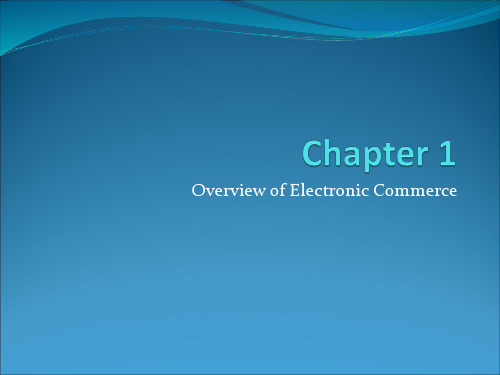
virtual (pure-play) organizations Organizations that conduct their business activities solely online
click-and-mortar (click-and-brick) organizations Organizations that conduct some e-commerce activities, usually as an additional marketing channel
consumers, and society. 10. List and describe the major limitations of EC.
2020/12/16
1-3
Electronic Commerce: Definitions and Concepts
electronic commerce (EC)
2020/12/16
1-4
Electronic Commerce: Definitions and Concepts
MAJOR EC CONCEPTS
Pure Versus Partial EC EC Organizations
brick-and-mortar (old economy) organizations Old-economy organizations (corporations) that perform their primary business offline, selling physical product
intranet An internal corporate or government network that uses Internet tools, such as Web browsers, and Internet protocols
click-and-mortar (click-and-brick) organizations Organizations that conduct some e-commerce activities, usually as an additional marketing channel
consumers, and society. 10. List and describe the major limitations of EC.
2020/12/16
1-3
Electronic Commerce: Definitions and Concepts
electronic commerce (EC)
2020/12/16
1-4
Electronic Commerce: Definitions and Concepts
MAJOR EC CONCEPTS
Pure Versus Partial EC EC Organizations
brick-and-mortar (old economy) organizations Old-economy organizations (corporations) that perform their primary business offline, selling physical product
intranet An internal corporate or government network that uses Internet tools, such as Web browsers, and Internet protocols
电子商务英文版最新课件ec13_ppt_ch09_accessible
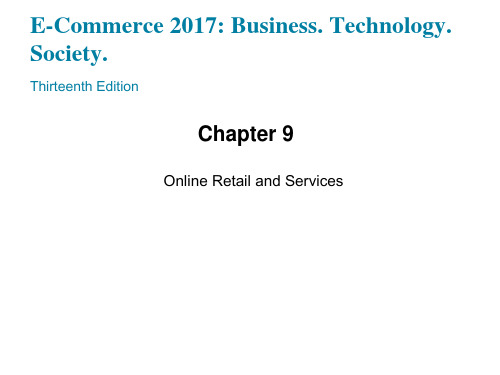
• Vision: – Earth's biggest selection, lowest prices, most customercentric
• Business model: – Retail, Third-Party Merchants, and Amazon Web Services
• Financial analysis: – Continued explosive revenue growth, profitable
ห้องสมุดไป่ตู้
What’s New in Online Retail
• Retail mobile e-commerce exploding • Social networks experiment with social e-commerce • Local e-commerce skyrockets to over $40 billion • Online retail still the fastest growing retail channel • Selection of goods increases, includes luxury goods • Specialty retail sites show rapid growth • New subscription-based model for online retailing • Big data used for predictive marketing
The Retail Industry
• 7 segments (clothing, durable goods, etc.) – For each, uses of Internet may differ ▪ Information vs. direct purchasing
• Business model: – Retail, Third-Party Merchants, and Amazon Web Services
• Financial analysis: – Continued explosive revenue growth, profitable
ห้องสมุดไป่ตู้
What’s New in Online Retail
• Retail mobile e-commerce exploding • Social networks experiment with social e-commerce • Local e-commerce skyrockets to over $40 billion • Online retail still the fastest growing retail channel • Selection of goods increases, includes luxury goods • Specialty retail sites show rapid growth • New subscription-based model for online retailing • Big data used for predictive marketing
The Retail Industry
• 7 segments (clothing, durable goods, etc.) – For each, uses of Internet may differ ▪ Information vs. direct purchasing
电子商务英文版最新课件ec13_ppt_ch12_accessible
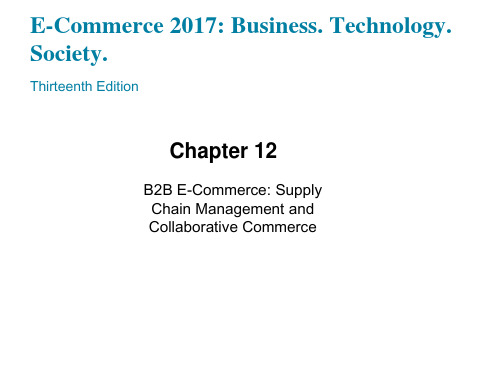
Basic Definitions
• B2B commerce: – All types of computer-enabled inter-firm trade – Before Internet, B2B transactions called trade or procurement process
Types of Procurement (2 of 2)
• Procurement is highly information intensive and labor intensive – Requires managing information among many corporate systems – Involves over 1 million U.S. workers
12.1 Discuss the evolution and growth of B2B e-commerce, as well as its potential benefits and challenges.
12.2 Understand how procurement and supply chains relate to B2B e-commerce.
• B2B e-commerce will grow to 51% of total U.S. inter-firm trade by 2020
• Private industrial networks continue to play dominant role in B2B
• Non-EDI B2B e-commerce most rapidly growing type of e-commerce
• B2B e-commerce: – The portion of B2B commerce enabled by the Internet
电子商务英文版最新课件ec13_ppt_ch02_accessible
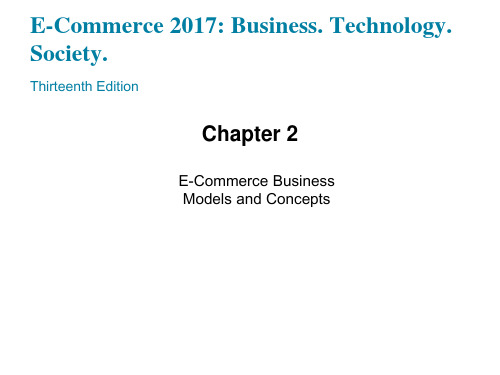
• Market opportunity typically divided into smaller niches
4. Competitive Environment
• “Who else occupies your intended marketspace?” – Other companies selling similar products in the same marketspace – Includes both direct and indirect competitors
E-Commerce Business Models
• Business model – Set of planned activities designed to result in a profit in a marketplace
• Business plan – Describes a firm’s business model
• E-commerce business model – Uses/leverages unique qualities of Internet and Web
Eight Key Elements of a Business Model
1. Value proposition 2. Revenue model 3. Market opportunity 4. Competitive environment 5. Competitive advantage 6. Market strategy 7. Organizational development 8. Management team
B2C Business Models
• E-tailer • Community provider (social network) • Content provider • Portal • Transaction broker • Market creator • Service provider
4. Competitive Environment
• “Who else occupies your intended marketspace?” – Other companies selling similar products in the same marketspace – Includes both direct and indirect competitors
E-Commerce Business Models
• Business model – Set of planned activities designed to result in a profit in a marketplace
• Business plan – Describes a firm’s business model
• E-commerce business model – Uses/leverages unique qualities of Internet and Web
Eight Key Elements of a Business Model
1. Value proposition 2. Revenue model 3. Market opportunity 4. Competitive environment 5. Competitive advantage 6. Market strategy 7. Organizational development 8. Management team
B2C Business Models
• E-tailer • Community provider (social network) • Content provider • Portal • Transaction broker • Market creator • Service provider
- 1、下载文档前请自行甄别文档内容的完整性,平台不提供额外的编辑、内容补充、找答案等附加服务。
- 2、"仅部分预览"的文档,不可在线预览部分如存在完整性等问题,可反馈申请退款(可完整预览的文档不适用该条件!)。
- 3、如文档侵犯您的权益,请联系客服反馈,我们会尽快为您处理(人工客服工作时间:9:00-18:30)。
• Content convergence – Three aspects: Design, production, distribution – New tools for digital editing and processing
• Industry convergence – Merger of media enterprises into firms that create and cross-market content on different platforms
production business • Continued growth of online video and music • E-book sales growth slows • Digital music sales top physical sales • Console games flatten as mobile games soar
• Class Discussion – Do you subscribe to any online video streaming services? If so, which ones? – What sites have given you the best overall viewing or entertainment experience, and why? – What are the advantages of watching traditional television over watching online TV and films?
Trends in Online Content (1 of 2)
• Mobile platform accelerates the transition to digital content • Distributors become significant players in content
• Four factors in decline – Growth of Web, mobile devices as alternative medium – Alternative digital sources for news – Failure to develop suitable new business models – Rise of social media and role of directing traffic to newspaper content
Figure 10.5 Convergence and the Transformation of Content: Books
Online Publishing Industry
• $93 billion based originally in print, moving rapidly to Internet
ห้องสมุดไป่ตู้
Figure 10.6 Newspaper Revenues 1980–2015
Figure 10.7 Online Newspaper Models 1995-2016
Online Newspaper Industry: Strengths and Challenges
• Strength: Newspaper audience size and growth • Challenge: Digital ad revenue • Strength: Content is king • Challenge: Finding a revenue model • Challenge: Growth of pure digital competitors • Challenge: Can newspapers survive digital disruption
Trends in Online Content (2 of 2)
• Four Internet titans compete for ownership of online content ecosystem: Apple, Google, Amazon, and Facebook
• Netflix the largest consumer of bandwidth
Free or Fee
• Early years: Internet audience expected free content but willing to accept advertising – Early content was low quality
• With advent of high-quality content, fee models successful – iTunes – Millions of users buy from legal music sites – YouTube cooperating with Hollywood and New York film production studios
Learning Objectives
10.1 Understand the major trends in the consumption of media and online content, the major revenue models for digital content delivery, digital rights management, and the concept of media convergence.
Digital Rights Management (DRM)
• Technical and legal means to protect digital content from unlimited reproduction and distribution
• DRM hardware and software encrypts content • Streaming content
10.2 Understand the key factors affecting the online publishing industry.
10.3 Understand the key factors affecting the online entertainment industry.
Cord Cutters and Cord Shavers: The Emerging Internet Broadcast System (IBS)
• Class discussion: – What are some of the defining socioeconomic and behavioral patterns of Millennials? – In what ways does the hard evidence about Millennials not fit stereotypes about them? – Why are Millennials so sought after by advertisers? – Do you self-identify as a Millennial? Why or why not?
Internet and Traditional Media
• Cannibalization vs. complementary – Does time on Internet reduce time spent with other media? – Massive shift of audience to Web, tablets, smartphones
E-Commerce 2017: Business. Technology. Society.
Thirteenth Edition
Chapter 10
Online Content and Media
Slides in this presentation contain hyperlinks. JAWS users should be able to get a list of links by using INSERT+F7
Figure 10.2 Media Revenues by Channel
Digital Content Revenue Models
• Online content delivery revenue models – Subscription – A la carte – Advertising supported (free/freemium)
– Difficult to copy – Walled garden
Media Industry Structure
• Three separate segments – Print – Movies – Music
• Each dominated by few key players with little crossover • Transmission industry highly oligopolistic
• Three segments – Online newspapers – E-books – Online magazines
Online Newspapers
• Most troubled segment of publishing industry – Revenues shrunk from $60 billion in 2002 to about $30 billion in 2015
• Cloud storage serves huge market for mobile device content
• FCC issues new net neutrality rules
• Time spent with digital media exceeds time spent with television
• Industry convergence – Merger of media enterprises into firms that create and cross-market content on different platforms
production business • Continued growth of online video and music • E-book sales growth slows • Digital music sales top physical sales • Console games flatten as mobile games soar
• Class Discussion – Do you subscribe to any online video streaming services? If so, which ones? – What sites have given you the best overall viewing or entertainment experience, and why? – What are the advantages of watching traditional television over watching online TV and films?
Trends in Online Content (1 of 2)
• Mobile platform accelerates the transition to digital content • Distributors become significant players in content
• Four factors in decline – Growth of Web, mobile devices as alternative medium – Alternative digital sources for news – Failure to develop suitable new business models – Rise of social media and role of directing traffic to newspaper content
Figure 10.5 Convergence and the Transformation of Content: Books
Online Publishing Industry
• $93 billion based originally in print, moving rapidly to Internet
ห้องสมุดไป่ตู้
Figure 10.6 Newspaper Revenues 1980–2015
Figure 10.7 Online Newspaper Models 1995-2016
Online Newspaper Industry: Strengths and Challenges
• Strength: Newspaper audience size and growth • Challenge: Digital ad revenue • Strength: Content is king • Challenge: Finding a revenue model • Challenge: Growth of pure digital competitors • Challenge: Can newspapers survive digital disruption
Trends in Online Content (2 of 2)
• Four Internet titans compete for ownership of online content ecosystem: Apple, Google, Amazon, and Facebook
• Netflix the largest consumer of bandwidth
Free or Fee
• Early years: Internet audience expected free content but willing to accept advertising – Early content was low quality
• With advent of high-quality content, fee models successful – iTunes – Millions of users buy from legal music sites – YouTube cooperating with Hollywood and New York film production studios
Learning Objectives
10.1 Understand the major trends in the consumption of media and online content, the major revenue models for digital content delivery, digital rights management, and the concept of media convergence.
Digital Rights Management (DRM)
• Technical and legal means to protect digital content from unlimited reproduction and distribution
• DRM hardware and software encrypts content • Streaming content
10.2 Understand the key factors affecting the online publishing industry.
10.3 Understand the key factors affecting the online entertainment industry.
Cord Cutters and Cord Shavers: The Emerging Internet Broadcast System (IBS)
• Class discussion: – What are some of the defining socioeconomic and behavioral patterns of Millennials? – In what ways does the hard evidence about Millennials not fit stereotypes about them? – Why are Millennials so sought after by advertisers? – Do you self-identify as a Millennial? Why or why not?
Internet and Traditional Media
• Cannibalization vs. complementary – Does time on Internet reduce time spent with other media? – Massive shift of audience to Web, tablets, smartphones
E-Commerce 2017: Business. Technology. Society.
Thirteenth Edition
Chapter 10
Online Content and Media
Slides in this presentation contain hyperlinks. JAWS users should be able to get a list of links by using INSERT+F7
Figure 10.2 Media Revenues by Channel
Digital Content Revenue Models
• Online content delivery revenue models – Subscription – A la carte – Advertising supported (free/freemium)
– Difficult to copy – Walled garden
Media Industry Structure
• Three separate segments – Print – Movies – Music
• Each dominated by few key players with little crossover • Transmission industry highly oligopolistic
• Three segments – Online newspapers – E-books – Online magazines
Online Newspapers
• Most troubled segment of publishing industry – Revenues shrunk from $60 billion in 2002 to about $30 billion in 2015
• Cloud storage serves huge market for mobile device content
• FCC issues new net neutrality rules
• Time spent with digital media exceeds time spent with television
